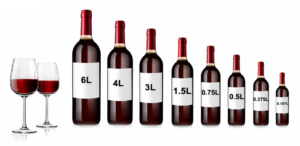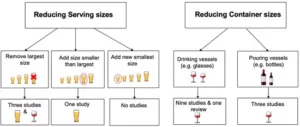
People consume more food and non-alcoholic drinks when presented with larger portions or packages, and when using larger items of tableware, such as plates or glasses. But what about when presented with larger servings and containers of alcohol? We conducted a review to summarise the evidence for the influence of the size of servings glasses and bottles on how much people drink, to investigate whether making sizes smaller could reduce alcohol consumption across populations, thereby improving health.

We found 10 relevant published reports of 15 studies and one review. Twelve studies and the review focused on wine drinking, one study on beer and two on both. All were conducted in England, by just two research groups.

Four studies focused on serving size. The results suggest that reducing the sizes in which alcohol is served decreases consumption when the largest serving size is removed and replaced by a smaller size. Adding a serving size slightly smaller than the largest size without removing the largest size doesn’t seem to have an effect
Eight studies and the review focused on glass size. The results suggest that reducing the size of glasses in which wine is served in restaurants decreases wine sales. Using smaller wine glasses at home may also reduce consumption but the evidence for this is less certain.
Three studies focused on bottle size. The results suggest that drinking smaller bottles may reduce wine consumption at home but this is more certain with 500 mL bottles than with 375 mL bottles.
Taken together, the existing evidence suggests that reducing the size of servings, glasses and bottles could reduce how much wine people drink. The effect of similar interventions with other alcoholic drinks awaits study. There is also a need for studies that test whether these effects are observed in other countries and contexts.
Written by Dr Eleni Mantzari and Professor Dame Theresa Marteau DBE, Department of Public Health and Primary Care, University of Cambridge.
All IAS Blogposts are published with the permission of the author. The views expressed are solely the author’s own and do not necessarily represent the views of the Institute of Alcohol Studies.
